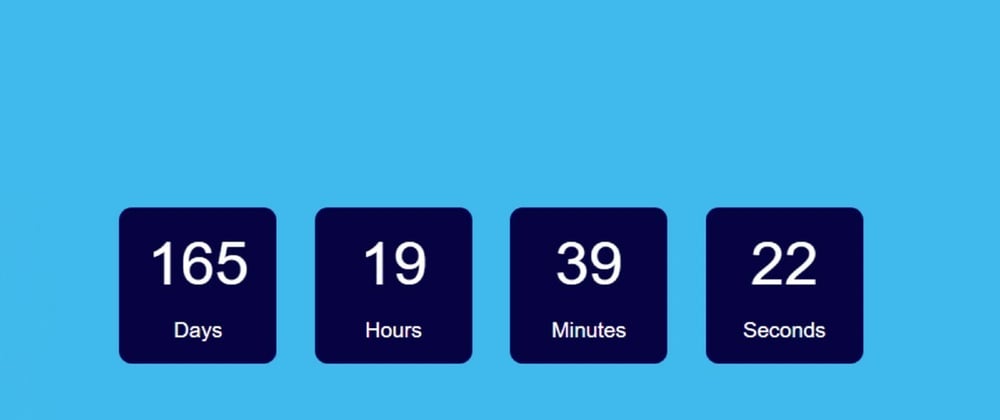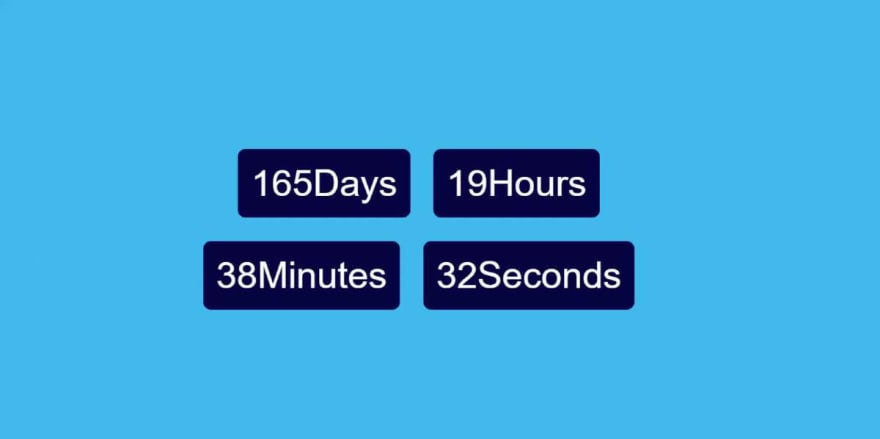JavaScript countdown timers are used on a variety of e-commerce and under-construction websites to keep users up to date. We see on different types of e-commerce websites that a kind of countdown starts some time before the arrival of any product or offer.
In this article I have created a countdown timer using simple JavaScript code and shared it with you.
✅ Watch Live Preview 👉👉 JavaScript Countdown Timer
Creating such a project is much easier if you know how to create a digital clock. Here you can schedule a specific day or time in advance. Then, with the help of JavaScript code, subtracting the current time from that time, the subtraction is reduced every second.
As you can see in the picture above I have used the web page background # 90cbf3 here. The page contains four small boxes for days, hours, minutes and seconds, respectively. First of all you have to create an HTML and CSS file.
Step 1: Basic structure of Countdown Timer
Only one line of HTML programming code has been used. Then I designed the webpage using the css code below. With background # 90cbf3 you can use any other color you want.
<div id="timer"></div>
body {
text-align: center;
padding: 100px 60px;
background: #90cbf3;
font-family: sans-serif;
font-weight: lighter;
}
Step 2: Activate it using JavaScript code
Now I have implemented this javascript countdown timer with the help of JavaScript. First of all, we have set a specific date with the help of Date.parse. that is, you have to determine for what time you want to run the countdown.
future = Date.parse("jun 12, 2022 01:30:00");
Then using the new Date () method I have taken the current time from the device. In this case, let me tell you, the time to use here is not the time of any server. It is only the local time of your device.
Then I subtract the current time from the pre-determined time and store it in the diff (constant). As a result, I have got a total of how much time to countdown.
now = new Date();
diff = future - now;
Now I have converted the total time of countdown to days, hours, minutes and seconds using JavaScript's Math.floor.
➤ We know that one second is equal to 1000 milliseconds, so we have divided the whole countdown time (diff) by 1000.
➤ Right now one minute is equal to 60 seconds so in this case we have divided by 1000 * 60.
➤ Since one hour is equal to 60 minutes, in this case we have divided by 1000 * 60 * 60.
➤ One day is equal to 24 hours so in this case it is divided by 1000 * 60 * 60 * 24.
days = Math.floor(diff / (1000 * 60 * 60 * 24));
hours = Math.floor(diff / (1000 * 60 * 60));
mins = Math.floor(diff / (1000 * 60));
secs = Math.floor(diff / 1000);
d = days;
h = hours - days * 24;
m = mins - hours * 60;
s = secs - mins * 60;
Above we have done all the work of calculation, now we will arrange it neatly in the web page. For this I have used innerhtml and in it I have beautifully arranged how it can be seen in the webpage. Here I have added text like day, hours, minutes, seconds etc. using span respectively.
document.getElementById("timer")
.innerHTML =
'<div>' + d + '<span>Days</span></div>' +
'<div>' + h + '<span>Hours</span></div>' +
'<div>' + m + '<span>Minutes</span></div>' +
'<div>' + s + '<span>Seconds</span></div>';
Lastly, I have instructed to update this calculation every 1000 milliseconds using setInterval. Since the countdown time is intermittent every second, this system needs to be updated every second.
setInterval('updateTimer()', 1000);
Final JavaScript code
function updateTimer() {
future = Date.parse("jun 12, 2022 01:30:00");
now = new Date();
diff = future - now;
days = Math.floor(diff / (1000 * 60 * 60 * 24));
hours = Math.floor(diff / (1000 * 60 * 60));
mins = Math.floor(diff / (1000 * 60));
secs = Math.floor(diff / 1000);
d = days;
h = hours - days * 24;
m = mins - hours * 60;
s = secs - mins * 60;
document.getElementById("timer")
.innerHTML =
'<div>' + d + '<span>Days</span></div>' +
'<div>' + h + '<span>Hours</span></div>' +
'<div>' + m + '<span>Minutes</span></div>' +
'<div>' + s + '<span>Seconds</span></div>';
}
setInterval('updateTimer()', 1000);
Step 3: Give the times the size of a box
Now I have designed it using some basic css code and arranged it beautifully in web pages. As you can see in the picture above there is a small box to hold each time. I created that box using the code below. In this case I have used the background-color of the box # 020b43.
#timer {
font-size: 3em;
font-weight: 100;
color: white;
padding: 20px;
width: 700px;
color: white;
}
#timer div {
display: inline-block;
min-width: 90px;
padding: 15px;
background: #020b43;
border-radius: 10px;
border: 2px solid #030d52;
margin: 15px;
}
Step 4: Design the text
Now at the end of it all I will design the text that I added using the span in the JavaScript code. I have used the following css to determine the size, color, etc. of those texts.
#timer div span {
color: #ffffff;
display: block;
margin-top: 15px;
font-size: .35em;
font-weight: 400;
}
Hopefully from this tutorial you have learned how to build a countdown timer using JavaScript code. Please let me know in the comments how you like this tutorial. If I have done anything wrong, please let me know in the comments.
Related Post:
- Best Footer Design HTML CSS
- JavaScript Todo List
- Simple Stopwatch using JavaScript
- Skeleton Screen Loading Animation
- Javascript Age Calculator
- JavaScript Password Generator
- Automatic Image Slider in Html CSS
- Sidebar Menu Using HTML CSS
You can visit my blog for more tutorials like this.
https://www.foolishdeveloper.com/











Top comments (8)
What's the purpose of returning a function by your timer function instead of using 2 arguments?
As for your other changes I wanted to explain the very same things and couldn't agree more. However in my opinion your syntax to start the timer kinda looks ugla to be to be honest. The same goes for
timestampDiffseems only harder to read.Great Aritcle, It is good to clear the timer of the interval using
clearInterval()Full Code To clear interval in React
I see thank you for your detailed explanation. Maybe I should have asked my question in a different way 😅
I know that pattern but I don't like it that much.
The question should be more like "I don't get the advantage over calling one single method with multiple arguments" as it requires less memory in larger scales. When you have a loop or use this pattern in a recursion I think it's not worth it (of course in this case without something else it is trivial). If I really need such a case I prefer classes over that pattern as it's easier to read at the very first glance (when you have to dig through several hundred lines of code within a few seconds)
I guess it all depends on person preferences and what people are used too. Then again thanks for your code I bet it helps many people.
As much as I love languages with currying such as Ocaml, Haskell and F#, using it as a default in a language like Javascript is just going to confuse most readers. To be honest, it gives the impression that the author simply enjoys writing idiosyncratic code (which is confirmed by your statement about classes and the fact that you created an array just to be able to use map).
Here's my take.
Simple, short, readable, and unpretentious:
Welcome 😀
Thanks. Very helpful.
Some comments may only be visible to logged-in visitors. Sign in to view all comments.